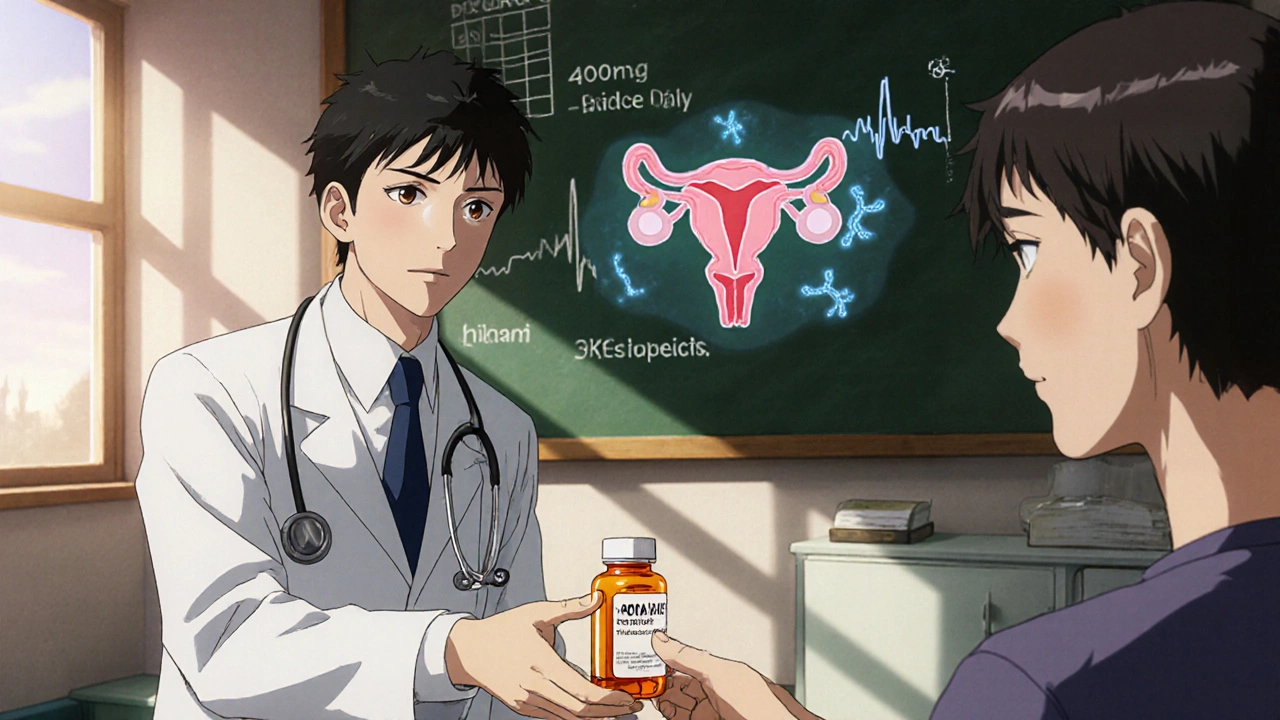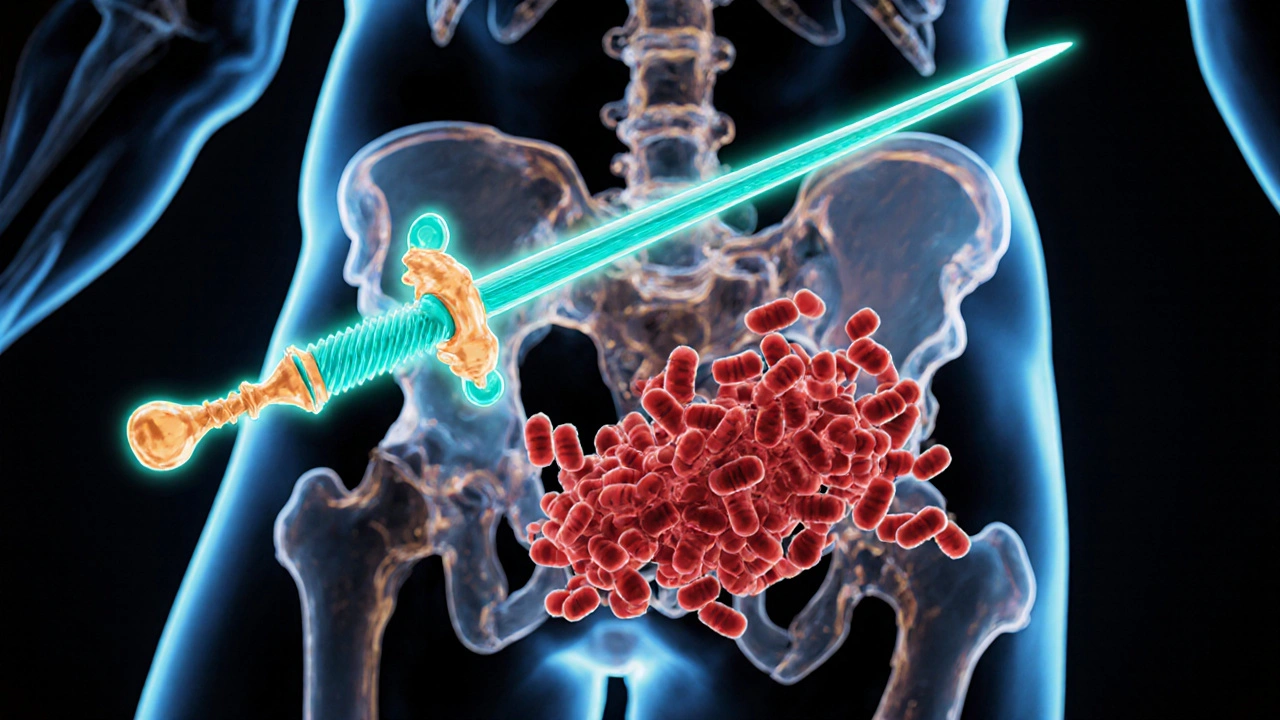Norfloxacin Dosing Calculator for Prostatitis
Calculate Norfloxacin Dosing
Recommended Dosing
Dose
Duration
Special Considerations
When discussing antibiotics for prostate infections, Norfloxacin is a fluoroquinolone that targets bacterial DNA replication by inhibiting DNA gyrase and topoisomerase IV. It is absorbed well from the gut and reaches therapeutic concentrations in the prostate tissue, which makes it a frequent choice for uncomplicated bacterial prostatitis.
Prostatitis is an inflammation of the prostate gland that can be caused by bacterial infection, trauma, or autoimmune factors. The bacterial form often stems from Gram‑negative organisms such as Escherichia coli, which ascend the urethra and colonize the prostate. Effective treatment hinges on delivering an antibiotic that can penetrate the gland’s dense tissue and maintain adequate levels over several weeks.
Why Norfloxacin Is Chosen for Prostatitis
The prostate’s blood‑prostate barrier limits drug entry, so agents with high lipid solubility and low protein binding are preferred. Norfloxacin’s pharmacokinetic profile meets these criteria, achieving prostate concentrations that are 30‑50% of serum levels. Clinical guidelines from the European Association of Urology (EAU) recommend fluoroquinolones like Norfloxacin as first‑line oral therapy for acute bacterial prostatitis when the pathogen is susceptible.
Typical Dosing Regimens
- Acute bacterial prostatitis: 400 mg orally twice daily for 4‑6 weeks.
- Chronic bacterial prostatitis: 400 mg orally twice daily for 6‑12 weeks, depending on culture results and symptom resolution.
- Adjustments for renal impairment: reduce dose to 200 mg twice daily if creatinine clearance is 30‑50 mL/min; avoid if <30 mL/min.
Patients should take Norfloxacin on an empty stomach or with a light meal to minimize binding to calcium‑rich foods, which can lower absorption. Consistency matters-missed doses should be taken as soon as remembered unless the next dose is near, in which case the missed dose is skipped.
Effectiveness and Supporting Evidence
Randomized controlled trials from the early 2020s compared Norfloxacin to other fluoroquinolones and found cure rates of 78‑85% for acute prostatitis when the isolate was susceptible. A meta‑analysis of seven studies (total n = 1,246) reported a pooled microbiological eradication rate of 81% for Norfloxacin versus 73% for trimethoprim‑sulfamethoxazole, highlighting its superiority in tissue penetration.
However, rising antibiotic resistance among uropathogens is eroding these numbers. In regions with high fluoroquinolone resistance (>20% of E. coli isolates), culture‑guided therapy is essential to avoid treatment failure.
Safety Profile and Common Side Effects
Like all fluoroquinolones, Norfloxacin carries a risk of tendonitis, peripheral neuropathy, and QT‑prolongation. The most frequently reported adverse events are gastrointestinal upset (nausea, diarrhoea), headache, and photosensitivity. Less common but serious reactions include:
- Tendon rupture, especially in patients over 60 or those on corticosteroids.
- Peripheral neuropathy that may be irreversible.
- Severe allergic reactions such as Stevens‑Johnson syndrome.
Patients with a history of epilepsy, prolonged QT interval, or concomitant use of drugs that affect cardiac repolarisation (e.g., macrolides, certain antipsychotics) should avoid Norfloxacin or be monitored closely.

Drug Interactions to Watch
Norfloxacin chelates divalent cations, so antacids, calcium supplements, and iron tablets should be spaced at least two hours apart. Co‑administration with warfarin can enhance anticoagulant effect, requiring INR monitoring. Additionally, other fluoroquinolones (e.g., Ciprofloxacin, Levofloxacin) share metabolic pathways and may lead to additive toxicity when combined.
Comparing Norfloxacin With Alternative Agents
| Feature | Norfloxacin | Ciprofloxacin | Levofloxacin |
|---|---|---|---|
| Typical dose | 400 mg BID | 500 mg BID | 500 mg QD |
| Prostate penetration | 30‑50% serum level | 20‑40% serum level | 40‑60% serum level |
| Renal adjustment needed | Yes, if CrCl < 50 mL/min | Yes, if CrCl < 30 mL/min | Minimal, mostly hepatic |
| Risk of tendon injury | Moderate | Higher | Lower |
| Cost (USD per 30‑day course) | $25‑$35 | $30‑$40 | $45‑$55 |
When choosing an agent, clinicians balance efficacy, side‑effect profile, patient comorbidities, and cost. For patients with moderate renal dysfunction, Norfloxacin’s dosage flexibility makes it attractive. For those at high risk of tendon damage, levofloxacin might be safer, albeit at a higher price point.
Special Populations
Pregnant or breastfeeding women should avoid Norfloxacin; animal studies have shown cartilage toxicity, and human data are insufficient. Pediatric use is limited to certain urinary infections, not prostatitis, as the prostate gland is not fully developed until adolescence.
Elderly patients often have reduced renal clearance and concurrent medications that increase QT risk. A careful review of drug lists and baseline ECG is advisable before initiating therapy.
Monitoring Treatment Progress
Symptoms such as dysuria, pelvic pain, and fever should improve within 48‑72 hours. If no improvement is seen, repeat urine and prostatic fluid cultures to verify susceptibility. Persistent infection may indicate resistant organisms, requiring a switch to a different class (e.g., carbapenems) or combination therapy.
Follow‑up labs should include renal function tests, liver enzymes (if using high‑dose or prolonged therapy), and, if indicated, a baseline and follow‑up ECG for patients on other QT‑prolonging drugs.
When Norfloxacin Fails
Failure can stem from three main issues: resistant pathogen, inadequate drug levels in the prostate, or an incorrect diagnosis (e.g., non‑bacterial chronic prostatitis). In resistant cases, susceptibility testing often reveals fluoroquinolone‑resistant E. coli, prompting a shift to agents like fosfomycin or a beta‑lactam/beta‑lactamase inhibitor combo.
Insufficient prostate concentrations may be addressed by extending treatment duration or using a higher‑dose regimen under specialist supervision. For non‑bacterial causes, anti‑inflammatory agents, alpha‑blockers, or physiotherapy may provide relief.
Key Takeaways
- When treating prostatitis, Norfloxacin remains a first‑line oral fluoroquinolone due to good prostate penetration.
- Standard dosing is 400 mg twice daily for 4‑12 weeks, adjusted for kidney function.
- Effectiveness is high against susceptible Gram‑negative bacteria but wanes where resistance is common.
- Monitor for tendon injury, QT changes, and drug interactions, especially with antacids and anticoagulants.
- Compare with ciprofloxacin and levofloxacin to tailor therapy based on patient factors.
Can Norfloxacin be used for chronic prostatitis?
Yes, it can be used for chronic bacterial prostatitis, but treatment typically lasts 6‑12 weeks and should be guided by culture results. Non‑bacterial chronic prostatitis requires a different approach.
What should I avoid while taking Norfloxacin?
Avoid dairy products, calcium, magnesium, or iron supplements within two hours of the dose, as they reduce absorption. Also steer clear of antacids containing aluminum or zinc.
Is it safe to take Norfloxacin if I have a heart condition?
Patients with a history of QT prolongation should use Norfloxacin cautiously. A baseline ECG and regular monitoring are recommended if combined with other QT‑prolonging drugs.
How long does it take to feel better?
Most patients notice symptom relief within two to three days. Full eradication of infection may require the entire prescribed course, even if symptoms disappear early.
What are the signs of tendon injury?
Sudden pain, swelling, or weakness in the shoulder, elbow, wrist, or Achilles tendon during or after activity warrants immediate medical attention, as fluoroquinolones can predispose to rupture.

Nathan S. Han
October 23, 2025 AT 23:01Reading through the mechanisms of Norfloxacin feels like watching a well‑choreographed ballet, where every step-DNA gyrase inhibition, topoisomerase blockage-leads to the graceful exit of harmful bacteria from the prostate.
What truly impresses me is the drug’s lipid solubility, allowing it to slip past the blood‑prostate barrier with ease.
Clinicians appreciate the straightforward dosing of 400 mg twice daily, which simplifies adherence for patients tangled in chronic pain.
Of course, the risk of tendonitis should never be ignored; a diligent follow‑up can catch early signs before disaster strikes.
Overall, Norfloxacin remains a solid first‑line option when culture data confirm susceptibility.
Just remember to separate antacids by a couple of hours to keep absorption on point.
Ed Mahoney
November 3, 2025 AT 22:01Oh great, another fluoroquinolone, because my life wasn’t already a cocktail of side‑effects.
Brian Klepacki
November 14, 2025 AT 22:01The drama of antimicrobial therapy reaches its zenith when one considers Norfloxacin’s place in the theater of prostatitis management, a stage where only the most daring agents dare to perform.
First, let us extol the virtue of its molecular elegance: by binding to DNA gyrase and topoisomerase IV, it orchestrates a symphony of bacterial demise that echoes through the cavernous folds of the prostate.
Such precision is a rarity, for most agents balk at the blood‑prostate barrier, yet Norfloxacin saunters across with a lipid‑laden confidence that would make a seasoned actor blush.
The dosing regimen-400 mg BID for a span of four to twelve weeks-reads like a script that promises both intensity and endurance, demanding the patient’s unwavering commitment.
However, every protagonist bears a tragic flaw; here, the Achilles’ heel manifests as tendon toxicity, QT prolongation, and an ominous propensity for peripheral neuropathy.
One must therefore summon the wisdom of vigilant monitoring, lest the very drug that heals become the harbinger of irreversible harm.
Consider, too, the pharmacokinetic ballet wherein renal impairment dictates a graceful dose reduction, a subtle yet vital pirouette in patient safety.
When juxtaposed with ciprofloxacin and levofloxacin, Norfloxacin’s moderate tendon‑injury risk and cost‑effectiveness offer a compelling middle ground.
Yet, the rise of fluoroquinolone‑resistant Escherichia coli looms like a dark cloud, threatening to eclipse the drug’s once‑bright reputation.
In such ominous skies, culture‑guided therapy ascends as the lighthouse, directing clinicians toward alternative vessels such as fosfomycin or beta‑lactam combos.
Nevertheless, for the patient whose renal function hovers just above the threshold, Norfloxacin’s adjustable dosing provides a rare reprieve.
The artful clinician must weigh the scales of efficacy, safety, and economics, lest they tip into the abyss of overtreatment or under‑treatment.
Even the most seasoned urologist will recall the cardinal rule: a symptom‑free window of 48‑72 hours heralds therapeutic success, but persistence beyond that mandates re‑evaluation.
Thus, Norfloxacin stands not merely as a pill, but as an emblem of the delicate balance between microbial conquest and human frailty, a drama that continues to unfold with each prescription.
In the end, the true measure of its worth lies in the patient's restored quality of life.
Selina M
November 25, 2025 AT 22:01Totally agree, the drug hits the spot and the side‑effects are worth watching out for. Stay safe and keep those antacids apart!
Nicholai Battistino
December 6, 2025 AT 22:01Prostate penetration is key; Norfloxacin hits the target.
Katherine Collins
December 17, 2025 AT 22:01Sounds like a solid plan, just don’t forget the timing – :)